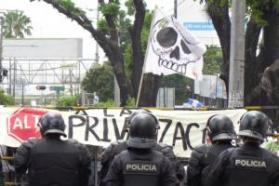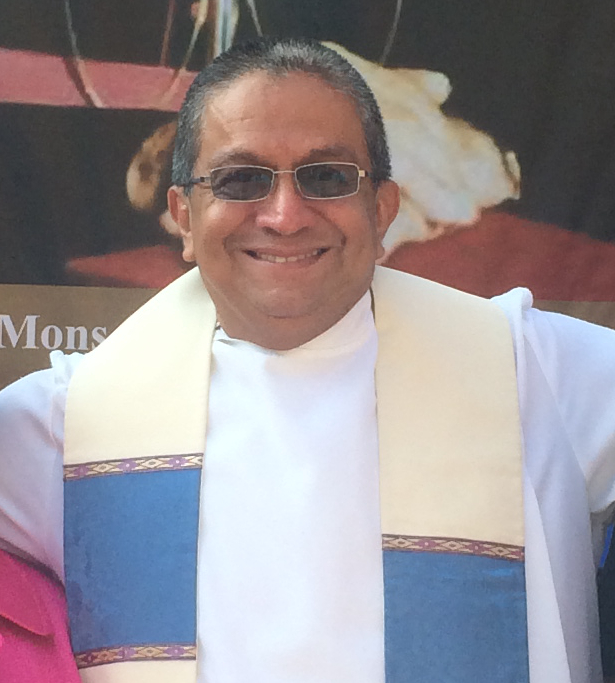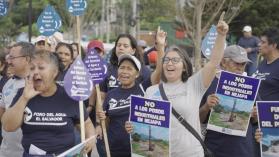TIMELINE OF EVENTS AROUND JULY 2 ARRESTS OF WATER PRIVATIZATION PROTESTORS
- A non-violent protest had been organized inSuchitoto for Monday morning, July 2nd, 2007. The protest was organized by the Association for the Development of ElSalvador (CRIPDES), its regional branch in Suchitoto (PROGRESO), and the peopleof the organized rural communities in that municipality, as well as the theUnion of Water Workers (SETA) and a number of other social organizations.
- This protest coincided with the visit of PresidentElias Antonio Saca and his cabinet to Suchitoto. The purpose of this visit was to inauguratethe public water system in the municipality and with it a Plan for theDecentralization of Public Services, a policy which is viewed as a step towardsprivatization of the public water system. The communities, organized and accompanied by CRIPDES, staged ademonstration and other public protest activities around the visit of PresidentSaca and in opposition to the movement toward privatization of water.
- Four members of the Association for the Developmentof El Salvador (CRIPDES) were arrested before their vehicle reached theprotest, when their vehicle was stopped by National Civilian Police (PNC)several kilometres before they arrived in Suchitoto, outside the community ofMilingo. There a police car pulled infront of them and blocked their path, and officers forcefully arrested thefollowing people: Marta Lorena Araujo, President of the CRIPDES National DirectiveCouncil; Rosa Valle Centeno, Vice-President CRIPDES National Directive Council;María Haydee Chicas, CRIPDES journalist and photographer; and Manuel AntonioRodriguez, driving the CRIPDES vehicle.
- Manuel Antonio Rodriguez, the driver of the vehicle,was struck violently by police officers immediately after the officersapproached the car. All four CRIPDESmembers were handcuffed and thrown into an army vehicle, which took themthrough back roads to the police station in Suchitoto.
- Shortly thereafter, the CRIPDES leaders arrested weretaken from Suchitoto police station to Cojutepeque, the capitol of the Cuscatlán Province. From there they were then taken to the policestation in Santa Cruz Analquitos, to the south of Cojutepeque. As of July 4, all the detainees were beingheld once more in Cojutepeque.
- Those arrested were charged with Creating PublicDisorder, and lawyers who had been in contact with the police headquarters inCojutepeque confirmed that their case will be designated under those charges tothe Cojutepeque departmental attorneys and court system. Under Salvadoran law the departmentalprosecutors have 72 hours (that is, until late morning or midday on the 5th ofJuly) to present charges at a public hearing.
- Despite the charges of Creating Public Disorder,the CRIPDES leaders arrested never came close to the protest activities beingcarried out in Suchitoto. News footageshown on the Salvadoran Tele-Corporation (TCS) channels clearly showed thepolice vehicle overtaking the CRIPDES truck on the paved road between Suchitotoand San Martín, swerving in front and stopping the CRIPDES leaders. The video also shows the police forcefullyremoving the passengers from the pick-up truck, and taking them away inhandcuffs, several kilometres away from where the protest took place. (Some news footage can be viewed at: http://www.youtube.com/watch?v=-e9Npsw4Xl8)
- When news of the arrest reached the protesters inSuchitoto on the morning of July 2, the people moved from the central parkprotest site to the police station to demand information and the liberation ofthose arrested.
- The police found themselves surrounded, and calledin the UMO (Unit for Maintenance of Order) Riot Police, who forcefullydispersed the crowds with tear gas, rubber bullets and wooden batons.
- Repression of the protest was not limited to thecrowd at the police station; rather it was widespread. As of the evening of July 3, preliminaryreports indicate that a total of 13 people were arrested (including the 4CRIPDES members and 9 local community members), 25 injured by rubber bullets,18 suffering serious effects of tear gas, 2 hospitalized, and an undeterminednumber beaten by police officers.
- In the community of Guillermo Ungo, severalkilometres south of Suchitoto, where the UMO riot police attacked communitymembers on the road on their way to the Suchitoto protests, again using rubberbullets and tear gas, forcing the community members to flee into the hills. Police also entered the homes of communitymembers in Guillermo Ungo without legal warrant to do so.
- Fleeing community members were followed by the UMOriot police and the Police Reaction Groups (GRPs) by land and by air for morethan 4 hours, with several arrests made. School classes in the nearby community were suspended because of theeffects of the tear gas.
- The local community members captured reportpsychological intimidation after their arrest. One report reveals that detainees were taken in a helicopter above LagoSuchitlán and told by the police holding them that they were going to be thrownout of the helicopter.
- These specific tactics of repression, intimidation,persecution by helicopter, and invasion of homes are reminiscent of the mostpainful and disturbing moments of the armed conflict in El Salvador during the 1980s. This repressive events of July 2 represent astep backwards in the process of building democracy that was proposed with thesigning of the Peace Accords of 1992.
- Meanwhile, on the same morning as the protests inSuchitoto, the PNC and Salvadoran Armed Forces concluded a massive operation ofsome 300 officers who worked to capture Mario Belloso, the man accused ofkilling two police officers during a protest last July. Belloso was apprehendedin his own home during the early morning and then paraded in front of newscameras shortly thereafter. The storyfilled newspaper and television reports and gave Minister of Security ReneFigueroa and PNC Director Rodrigo Avila the opportunity to attack youthorganizations and the FMLN, insinuating that these groups have been aiding Belloso in hisefforts to evade arrest over the last year.
- In the raidof Bellosos home, the PNC claims to have found FMLN paraphernalia, along withspecific documents in his computer that tie him to various youthorganizations. Perhaps the mostridiculous claim made by President Saca is that Belloso was the intellectualauthor of the disturbances in Suchitoto; Figuero and Avila, meanwhile, accused the FMLN of beingbehind the protests. In an officialcommuniqué following the arrest of Belloso the FMLN stated that, We reject andrepudiate the coarse pretenses of extreme right-wing politicians, as well ascertain news media aligned with the party in power, who are blaming our partyfor the regretful events of July 5, 2006. Only perverse minds would have thecourage to make such unfounded accusations. Human Rights Office ombudswoman Beatrice de Carrillo called the arrest apolitical show by the government, while Ricardo Alfaro Barahona of the Forumfor the Defense of the Constitution raised questions about the timing of thearrest, as it coincided precisely with the police repression in Suchitoto.
- On themorning of July 5, the prosecutors asked for an extension to make formalcharges and the courts gave them until Saturday morning, and it came out thatthere are actually 14 people who were arrested. Unlike usual procedure which would have had that hearing in a the maincourt system, this case is being heard in the special, expedited tribunalscreated this December under the anti-organized crime law meant to hear casesagainst those charged with participation in organized crime. There is already one high-profile case movingthrough these special tribunal courts (of questionable constitutionality) thestates case charging street vendors with terrorism and organized crime. See here for more information about thevendors . This case against the water protestors is nowthe second case of the government using the new terrorism and organized crimelaws against the organized social movement. For an analysis of the anti-terrorism charges, see The SalvadoranAnti-Terrorism Law and its Mirror Image.

 "I am a CISPES supporter because continuing to fight for social justice and a more people-centered country means continuing the dream and sacrifice of thousands of my fellow Salvadorans who died for that vision.” - Padre Carlos, New York City
"I am a CISPES supporter because continuing to fight for social justice and a more people-centered country means continuing the dream and sacrifice of thousands of my fellow Salvadorans who died for that vision.” - Padre Carlos, New York City

